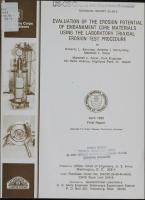Please use this identifier to cite or link to this item:
https://hdl.handle.net/11681/12658| Title: | Evaluation of the erosion potential of embankment core materials using laboratory triaxial erosion test procedure |
| Authors: | Sanchez, Roberto L. Strutynsky, Andrew I. Silver, Marshall L. |
| Keywords: | Density Filter Water content Earth dams Hydraulic gradient Eroding fluid Piping Erosion Triaxial erosion test Soils Soil testing Soil tests Embankments |
| Publisher: | Geotechnical Laboratory (U.S.) Engineer Research and Development Center (U.S.) |
| Series/Report no.: | Technical report (U.S. Army Engineer Waterways Experiment Station) ; no. GL-83-4. |
| Description: | Technical Report Abstract: Triaxial erosion tests were used to study how the erosion rate in typical embankment dam core materials is influenced by soil compaction and by the chemistry of the eroding fluid. The tests were performed in a specially modified triaxial cell which was able to apply confining pressure to compacted embankment dam materials and to direct the flow of the eroding fluid through a preformed erosion channel to model the conditions that exist in the core of an embankment dam. In addition, tests were performed to develop a method for testing the effectiveness of filters in preventing erosion from cracked embankment dam core materials. Five typical embankment dam core materials ranging from silty to clayey soils were studied. The results of the investigation may be summarized as follows: a.) Varying the compacted density had little effect on erosion for silt materials compacted at the optimum molding water content. For clay materials , the erosion rate increased as the density decreased from 95 to 90 percent of standard Proctor maximum density. b.) Varying the molding water content had a significant effect on the erodibility of silt core material, but this effect was less important for clay core material. c.) The minimum erosion occurred when soil was compacted at or slightly above the optimum compaction water content. Significantly higher erosion occurred in specimens compacted dry of optimum. d.) Erosion rates increased slightly with a decrease in eroding fluid ionic concentration. This increase was more significant for silt core materials than for clay core materials. e.) Tests performed to study the effectiveness of using standard concrete sand (ASTM C 33) as a filter material for the downstream protection of cracked core materials showed that the filter sand was able to stop the erosion of even a highly erosive silt material under the action of hydraulic heads of up to 40 m, which was equivalent to a hydraulic gradient of 350. f.) The soil erosion rate asymptotically approached a material and eroding fluid dependent constant defined as the Maximum Erosion Rate. This constant facilitates the incorporation of laboratory erosion test data into embankment dam design criteria. NOTE: This file is large. Allow your browser several minutes to download the file. |
| Rights: | Approved for public release; distribution is unlimited. |
| URI: | http://hdl.handle.net/11681/12658 |
| Appears in Collections: | Technical Report |
Files in This Item:
| File | Description | Size | Format | |
|---|---|---|---|---|
| TR-GL-83-4.pdf | 24.16 MB | Adobe PDF |  View/Open |